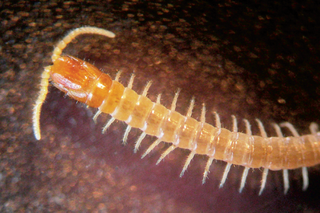
Himantariidae is a monophyletic family of centipedes in the order Geophilomorpha and superfamily Himantarioidea, found almost exclusively in the Northern Hemisphere. The number of leg-bearing segments in this family varies within as well as among species and ranges from 47 to 181. These centipedes are very elongated with a high mean number of trunk segments and great variability in this number within species. The maximum number of legs recorded in this family appears in the species Chomatobius bakeri. The minimum number of legs recorded in this family appears in the species Garriscaphus oreines, This family contains these genera:

Geophilus is a large, heterogeneous genus of soil centipedes in the family Geophilidae largely considered to be synonymous with Brachygeophilus. It is a mostly holarctic genus characterized by a claw-shaped ultimate pretarsus, anterior porefields, complete or nearly complete coxo-pleural sutures at the prosternum, and incomplete chitin-lines. Centipedes in this genus range from 1 cm to 8 cm in length. The generic name first appeared in Brewster's Edinburgh Encyclopaedia in 1814 as Geophilus electricus.

Tygarrup is a genus of centipedes in the family Mecistocephalidae, found mainly in southeast Asia and from the Seychelles to Hawaii. Although species in this genus can have either 43 or 45 leg-bearing segments, most of these species have 45 leg pairs. An undescribed Tygarrup species found in the Andaman Islands has 43 leg pairs. Centipedes in this genus range from 2 cm to 6 cm in length. Tygarrup javanicus is one of the smallest of the mecistocephalid species and has become an invasive in greenhouses in Europe.
Arrup is a genus of centipedes in the family Mecistocephalidae, native to Europe and Asia as far as Japan. These centipedes range from 1 cm to 5 cm in length. All species in this genus have 41 leg-bearing segments. Most are soil-dwellers but Arrup akiyoshiensis is a troglobiont.
Anarrup is a genus of centipedes in the family Mecistocephalidae, native to Europe and Asia as far as Indonesia. These centipedes range from 6 cm to 8 cm in length. All species in this genus have 41 leg-bearing segments.

Ballophilidae is a monophyletic group of centipedes belonging to the order Geophilomorpha and superfamily Himantarioidea. Authorities now dismiss this group as a family, citing phylogenetic analysis, and instead refer to this clade as Ballophilinae, a possible subfamily within the family Schendylidae. The number of legs in this clade varies within species and ranges from 37 to 113 pairs of legs. Two species in this clade can have as few as 37 leg pairs, Ballophilus pallidus and Leucolinum trinidadense, and one species, Ityphilus grandis, can have as many as 113 pairs. Species in this clade tend to have more leg-bearing segments and greater intraspecific variability in this number than generally found in the family Schendylidae.
Steneurytion is a genus of centipedes in the family Geophilidae. It was first described by Austrian myriapodologist Carl Attems in 1909.
Sepedonophilus hodites is a species of centipede in the Geophilidae family. It is endemic to Australia, and was first described in 1940 by American biologist Ralph Vary Chamberlin.
Tasmanophilus is a genus of two species of centipedes, in the family Zelanophilidae. It was described by American biologist Ralph Vary Chamberlin in 1920. Centipedes in this genus are found in Australia and New Zealand.
Tuoba is a genus of 17 species of centipedes, in the family Geophilidae. It was described by American biologist Ralph Vary Chamberlin in 1920.
Mecistocephalus is a genus of centipedes in the family Mecistocephalidae. It was described by British entomologist George Newport in 1843.
Lithobius moananus is a species of centipede in the Lithobiidae family. It was described in 1926 by American myriapodologist Ralph Vary Chamberlin.
Marsikomerus is a genus of centipedes in the family Schendylidae. It was described by Austrian myriapodologist Carl Attems in 1938. Species in this genus are found in Mexico and in the United States.
Marsikomerus bryanus is a species of centipede in the Lithobiidae family. It was described in 1926 by American myriapodologist Ralph Vary Chamberlin.
Nesomerium is a monotypic genus of centipedes in the family Geophilidae. It was described in 1953 by American myriapodologist Ralph Vary Chamberlin. The sole species is Nesomerium hawaiiense Chamberlin, 1953. Since the original description of this species based on a single specimen, no other specimens have been referred to this species or this genus, and some authorities express doubts about the validity of these taxa and their placement in the family Geophilidae.
Mecistocephalus waipaheenas is a species of centipede in the Mecistocephalidae family. It was described in 1953 by American myriapodologist Ralph Vary Chamberlin. This species can reach 25 mm in length and has a yellow body, a brown head, and 49 pairs of legs.
Mecistocephalus waikaneus is a species of centipede in the Mecistocephalidae family. It was described in 1953 by American myriapodologist Ralph Vary Chamberlin. This species is yellow, has 49 pairs of legs, and can reach 30 mm in length.
Mecistocephalus spissus is a species of centipede in the Mecistocephalidae family. It was described in 1862 by American biologist Horatio Curtis Wood. This species is dark yellow-brown, has 45 pairs of leg, and can reach 70 mm in length.
Endoptelus is a monotypic genus of centipedes in the family Oryidae. It was described in 1939 by American myriapodologist Ralph Vary Chamberlin. Its sole species is Endoptelus papuicolens Chamberlin, 1939.

Otostigminae is a large subfamily of centipedes, containing nearly half of all species in the family Scolopendridae. Members of this subfamily are abundant and widespread throughout the tropical and subtropical regions of the world, mostly in Africa, Asia, and Australia.




